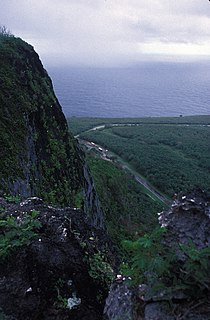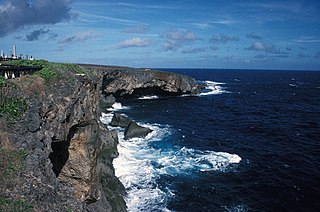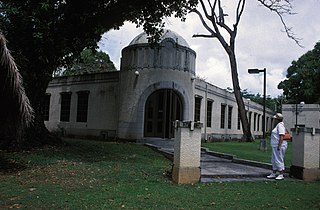Related Research Articles

Mañagaha is a small islet which lies off the west coast of Saipan within its lagoon in the Northern Mariana Islands. Although it has no permanent residents, Mañagaha is popular among Saipan's tourists as a day-trip destination due to its wide sandy beaches and a number of marine activities including snorkeling, parasailing and jet skiing.

A latte stone, or simply latte, is a pillar capped by a hemispherical stone capital (tasa) with the flat side facing up. Used as building supports by the ancient Chamorro people, they are found throughout most of the Mariana Islands. In modern times, the latte stone is seen as a sign of Chamorro identity and is used in many different contexts.

This is a list of the buildings, sites, districts, and objects listed on the National Register of Historic Places in the Northern Mariana Islands. There currently 37 listed sites spread across the four municipalities of the Northern Mariana Islands. There are no sites listed on any of the islands that make up the Northern Islands Municipality.

The Northern Mariana Islands national football team represents the Commonwealth of the Northern Mariana Islands in international men's football. The team is controlled by the governing body for football in the Northern Mariana Islands, the Northern Mariana Islands Football Association, which is a member of the East Asian Football Federation (EAFF) and since December 2020 a full member of the Asian Football Confederation (AFC). The association is not a member of the world governing body FIFA and so while the national team is eligible to enter AFC and EAFF-run competitions, they are currently ineligible for global competitions such as the FIFA World Cup. As such, they do not have an official FIFA ranking. However, the team have been consistently ranked as one of the worst teams in the world on the Elo ratings and were in fact, in July 2016 rated as the worst men's senior international team in the world in a ratings system that also includes a number of other non-FIFA teams. Following the completion of the preliminary qualifying round for the 2017 EAFF East Asian Cup the team have won only one official competitive match against international opposition and have a goal difference of −78 in official matches. The team have never qualified for the finals of a major tournament and beyond friendlies and qualifying matches, their only official competition has been in an exhibition tournament in the regional Micronesian Games in 1998, which they won, to date their only tournament success.

The House of Taga is an archeological site located near San Jose Village, on the island of Tinian, United States Commonwealth of the Northern Mariana Islands, in the Marianas Archipelago. The site is the location of a series of prehistoric latte stone pillars which were quarried about 4,000 feet (1,200 m) south of the site, only one of which is left standing erect due to past earthquakes. The name is derived from a mythological chief named Taga, who is said to have erected the pillars as a foundation for his own house.

The Japanese Lighthouse is an abandoned lighthouse situated atop Navy Hill in Garapan, Saipan, in the Northern Mariana Islands. It was listed on the National Register of Historic Places in 1974. The lighthouse is one of the few surviving pre-World War II, civilian structures built by the Japanese.

Suicide Cliff is a cliff above Marpi Point Field near the northern tip of Saipan, Northern Mariana Islands, which achieved historic significance late in World War II.

Banzai Cliff is a historic site at the northern tip of Saipan island in the Northern Mariana Islands, overlooking the Pacific Ocean. Towards the end of the Battle of Saipan in 1944, hundreds of Japanese civilians and soldiers jumped off the cliff to their deaths in the ocean and rocks below, to avoid being captured by the Americans. Not far away, a high cliff named Suicide Cliff overlooks the coastal plain, and was another site of numerous suicides. At Banzai Cliff, some who jumped did not die and were captured by American ships.

The Japanese Hospital or Saipan Byoin is a historic World War II-era hospital complex on Route 3 in Garapan, a village on the island of Saipan in the Northern Mariana Islands. The three concrete buildings are the largest Japanese-built structures to survive the war. The main hospital building is an L-shaped structure with a domed entrance at the crook of the L. A second, smaller building housed the pharmacy, while the third is an underground circular chamber of unknown purpose. All were in deteriorating condition when surveyed in the early 1970s. The complex has since undergone restoration, and the main hospital building now houses the Northern Mariana Islands Museum.

The Chugai' Pictograph Site is a prehistoric rock art site on the island of Rota in the Northern Mariana Islands. The rock art is located in a limestone cave on the southeastern side of the island, in the I'Chenchon Bird Sanctuary. It consists of a large panel, 185 feet (56 m) in length, of about 90 painted drawings, believed to be of late pre-contact origin. The site is accessed via a trail cut by the Japanese during the South Seas Mandate period.
The Dugi Archeological Site is a prehistoric latte stone site on the north side of Rota Island in the Northern Mariana Islands. The site is a rare inland site that survived the intensive sugar cane development introduced by the Japanese during the South Seas Mandate period of the 1920s and 1930s. It consists of sixteen deteriorated latte stone structures on three high terraces. Some of the latte stones have fallen over and others are missing features normally found at these sites.

The Waherak Maihar is a historic outrigger canoe on the island of Saipan in the Northern Mariana Islands. Built in 1958, it is a well-preserved example of a traditional Caroline Islands ocean-going canoe. It is 26 feet (7.9 m) long with a beam of 3 feet (0.91 m). It was constructed by the islanders of Poluwat from native materials, including coconut, pandanus, and breadfruit.

The Laulau Kattan Latte Site is a prehistoric archaeological site on the island of Saipan in the Northern Mariana Islands. Located near the shore of Laulau Bay, it is a small village site containing the remains of four latte stone house foundations, and an extensive scattering of pottery artifacts. When first reported by the pioneering archaeologist Alexander Spoehr in the 1940s, the latte stones were described as mostly fallen over and extremely weathered.

The Unai Lagua Japanese Defense Pillbox is one of the more unusual surviving World War II-era Japanese fortifications on the island of Saipan in the Northern Mariana Islands. It is located at the southern end of Unai Lagua, which stretches along the northern shore of the island. The pillbox is fashioned out of poured concrete and coral boulders, and uses natural rock formations as part of its walls. This construction was necessitated by a severe shortage of building materials on the island as the Japanese prepared the island's defenses against the advancing Allied forces in 1943–44. The use of natural materials and terrain had the added benefit of rendering the position nearly invisible to aerial or offshore observation.
The Unai Obyan Latte Site is a prehistoric archaeological site on the island of Saipan in the Northern Mariana Islands. Located near Obyan Beach on the south coast of the island, it is the site of what was once a fairly extensive village, which was significantly disturbed by Japanese defensive preparations during World War II. The site includes the fragmentary remains of a single latte stone house site and a wide scattering of surface-level remains. Excavation of the latte house site in the 1940s by the pioneering archeologist Alexander Spoehr yielded evidence of a length period of occupation. The village at Obyan was documented in early Spanish accounts of the island, and was probably abandoned when the Spanish forcibly relocated the entire island population to Guam in 1698.
Chalan Galaide is a late prehistoric latte stone archaeological site on the island of Saipan in the Northern Mariana Islands. It is unusual as one of the few inland latte sites in the Northern Marianas. It is a single-component site dating to the late prehistoric, or Latte Period, in the island's history. Based in part on the local name for the area and the presence of suitable tree species, it has been suggested the site was important in the production of canoes..
The Unai Achugao Archaeological Site is a major archaeological site on the island of Saipan in the Northern Mariana Islands. This site is one of the first sites at which reliable radiocarbon dates were acquired for the early habitation of the island, which were dated to about 3500 BCE. Excavations at the site also yielded more than 3,000 pottery fragments, which were used in the early classification of pottery types in the region. The site also included a nearly-intact habitation surface which was protected by a fossilized coral reef.

Mochong is a major prehistoric archaeological site on the island of Rota in the Northern Mariana Islands. It is considered the best preserved and largest latte village in the Marianas. ' It is an extensive village site on the northern side of the island with 47 latte stone house sites, including an extremely rare structure with 14 columns. It also has a latte stone wall, consisting of six columns and five slabs, that is more than 50 feet (15 m) long. The site has been radiocarbon dated to c. 1000 BCE. The site was first sketched in the early 19th century by the French explorer Louis de Freycinet, and was in remarkably intact condition in the 1980s.
The Garapan Heritage Trail is located in Garapan, Saipan, Northern Mariana Islands. The cultural heritage trail project is supported through grants awarded to the Northern Marianas Humanities Council by the National Endowment for the Humanities and the Office of Insular Affairs, United States Department of the Interior.
References
- 1 2 "National Register Information System". National Register of Historic Places . National Park Service. July 9, 2010.
- ↑ Morgan, William (2010). The Prehistoric Architecture of Micronesia. University of Texas Press. pp. 129–133. ISBN 9780292786219.